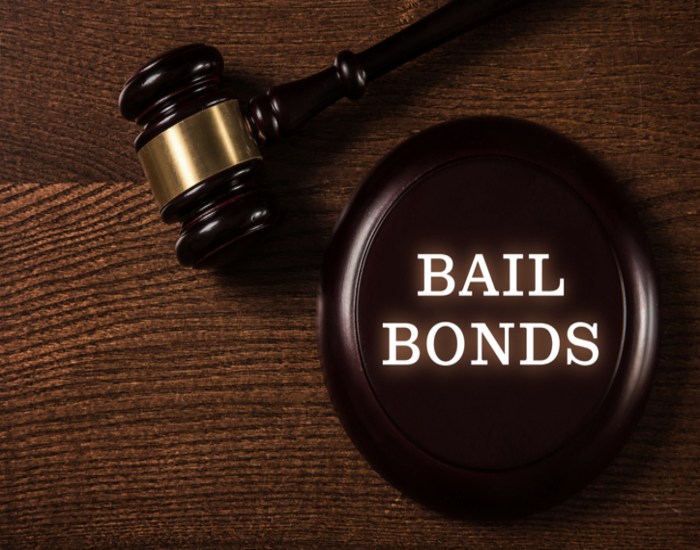Streamlining the Bail Refine: Your Guide to Bail Bonds
Navigating the bail process can frequently feel overwhelming, especially for those unknown with the different kinds of bond bonds and the actions entailed in protecting release. Once apprehended, the succeeding bond hearing will figure out the financial responsibilities needed for release.
Recognizing Bail Fundamentals
While the lawful system can commonly appear daunting, understanding the basics of bond is necessary for browsing the intricacies of pretrial launch. Bond functions as a financial warranty that an offender will show up in court for their set up hearings. When a person is jailed, a judge establishes the bond quantity based upon a number of factors, consisting of the nature of the crime, the offender's criminal history, and the danger of flight.
Bail can take various types, including cash money bond, where the accused pays the full quantity upfront, or guaranty bonds, where a bondsman ensures the bail for a cost. If the accused falls short to appear in court, they waive the bond quantity, which can lead to extra legal consequences.
Sometimes, people may be released on their very own recognizance, indicating they do not require to pay bond yet has to promise to return for their court days. Comprehending these foundational principles is crucial for accuseds and their family members as they browse the bail process, making sure educated decisions are made throughout a difficult time.
How Bond Bonds Work
Understanding just how bond bonds job is vital for anybody involved in the bond process. A bail bond is a legitimately binding agreement between a bondsman, the defendant, and the court. When a defendant is detained, a judge establishes a bond amount planned to ensure the individual's appearance at future court hearings. If the offender can not pay for to pay the complete bond amount, they can look for the services of a bondsman.
The bail bondsman typically charges a non-refundable charge, generally around 10-15% of the overall bond amount. This charge stands for the bondsman's settlement for assuming the financial danger related to the bond. As soon as the fee is paid, the bondsman posts the full bond amount to the court, securing the accused's release from custodianship.
For this service, the bondsman might need security, such as home or assets, to mitigate potential losses if the accused falls short to show up in court. If the offender does not go to the scheduled hearings, the bondsman can recoup the bail amount with legal means, which may include hiring a fugitive hunter. Understanding this procedure can help individuals navigate the complexities of safeguarding a bail bond successfully.
Types of Bail Bonds
After safeguarding a bail bond, it is necessary to acknowledge that not all bond bonds are the exact same; they can be found in various kinds designed to fit different circumstances and needs. One of the most common kind is the guaranty bond, which involves a bondsman who guarantees the complete you can try here bail amount to the court in exchange for a fee, typically around 10% of the total bond. This is excellent for those who can not afford to pay the complete bond quantity upfront.
An additional kind is the money bond, where the offender or their depictive pays the complete bond amount in money straight to the court. This option is usually made use of when people have the financial ways and prefer to recover their funds upon court appearance.
Residential property bonds enable individuals to make use of realty as collateral for bond. bail bond company newark ohio. This needs a home appraisal and can be complicated, however it is useful for those that possess beneficial properties
Last but not least, some jurisdictions offer individual recognizance bonds, where the defendant is launched based upon a guarantee to appear in court without any kind of monetary responsibility. Understanding these kinds of bond bonds is important for making notified choices in your scenario.
The Bond Process Actions
Navigating the bail process entails several crucial steps that can considerably impact the outcome of an accused's situation. The procedure generally begins with the apprehension, throughout which the individual is nabbed. As soon as arrested, the accused will be informed of the fees and may have a bail hearing set up, where a court will establish the bond amount based upon the extent of the crime, trip danger, and criminal background.
After the bond amount is established, the offender or their agent can read review get in touch with a bail bondsman. The bond bondsman will assess the situation, discussing the terms of the post bail bond and the charges involved, which typically amount to a percent of the complete bail. If an agreement is reached, the bondsman will post the bond with the court, permitting the accused to be launched from custody.

Tips for Selecting a Bail Representative
Selecting a bond agent is an essential action that can significantly affect the bail procedure. It is important to select a representative who not just comprehends the lawful complexities yet likewise provides trusted support throughout this stressful time. Begin by researching accredited bail representatives in your location; ensure they have the required qualifications and experience in handling your certain situation.
A reliable bail agent must display professionalism and reliability, empathy, and transparency. Do not think twice to ask concerns regarding their fees, procedures, and any kind of prospective collateral requirements.
Additionally, take into consideration the schedule and responsiveness of the bond agent. A good representative must be easily accessible 24/7, prepared to offer assistance whenever essential. Review their interaction style; a representative who listens and explains plainly can make the procedure much more manageable.

Final Thought
In conclusion, navigating the bail process needs a clear understanding of the numerous kinds of bond bonds and the step-by-step steps involved. Engaging with a certified bail bondsman is critical for facilitating release while guaranteeing compliance with court responsibilities.
Browsing the bond procedure can often feel overwhelming, particularly for those unfamiliar with the various types of bail bonds and the steps involved in securing release.Understanding how bail bonds work is essential for anyone entailed in the bond procedure. A bail bond is a lawfully binding contract between a bail bondsman, the defendant, and the court.After safeguarding a bail bond, it is vital to identify that not all bond bonds are the exact same; they come in different types designed to match various circumstances and requirements. The most common type is the guaranty bond, which entails a bond bondsman who guarantees the complete bond amount to the court in exchange for a charge, normally around 10% of the overall bail.